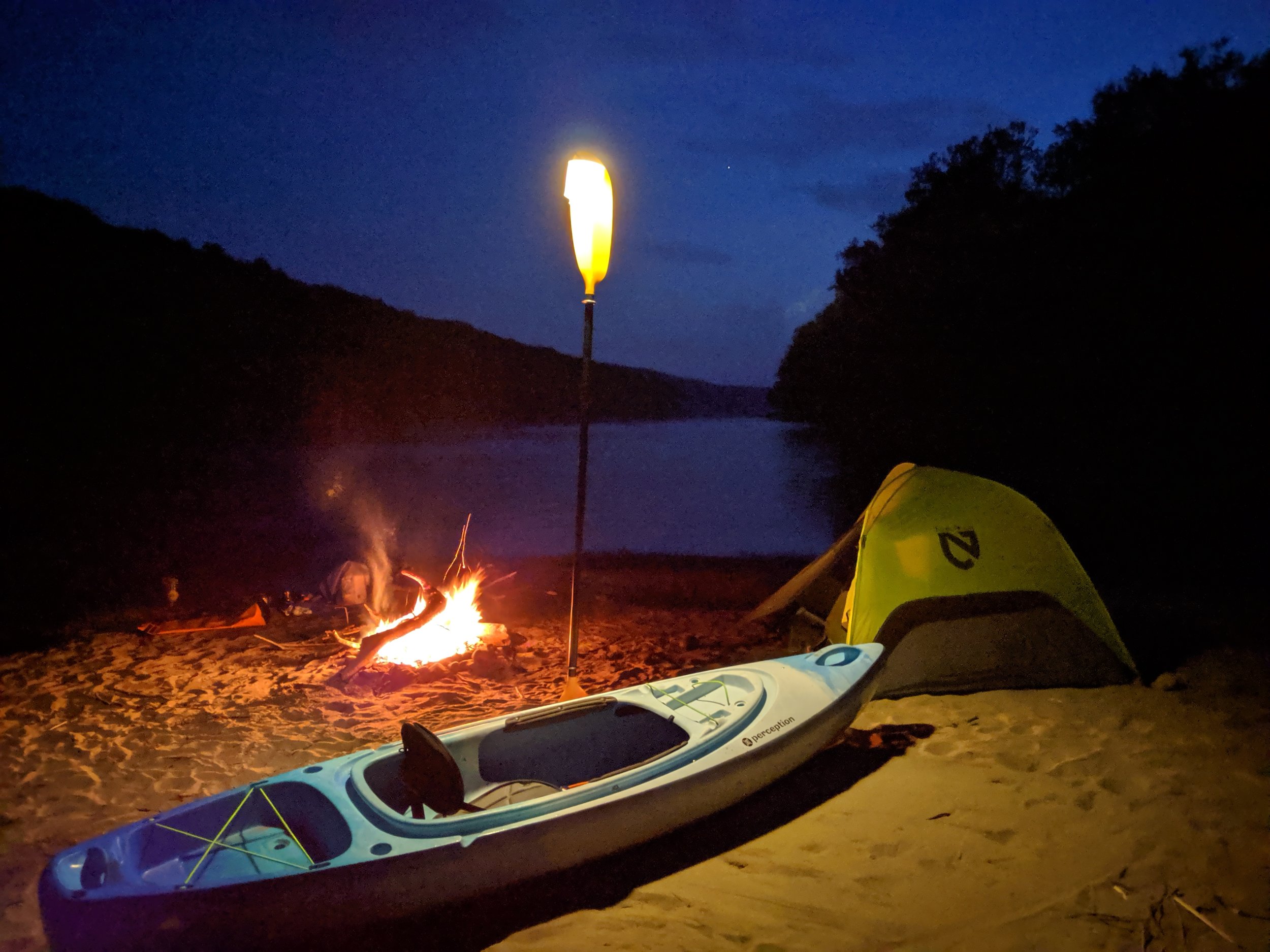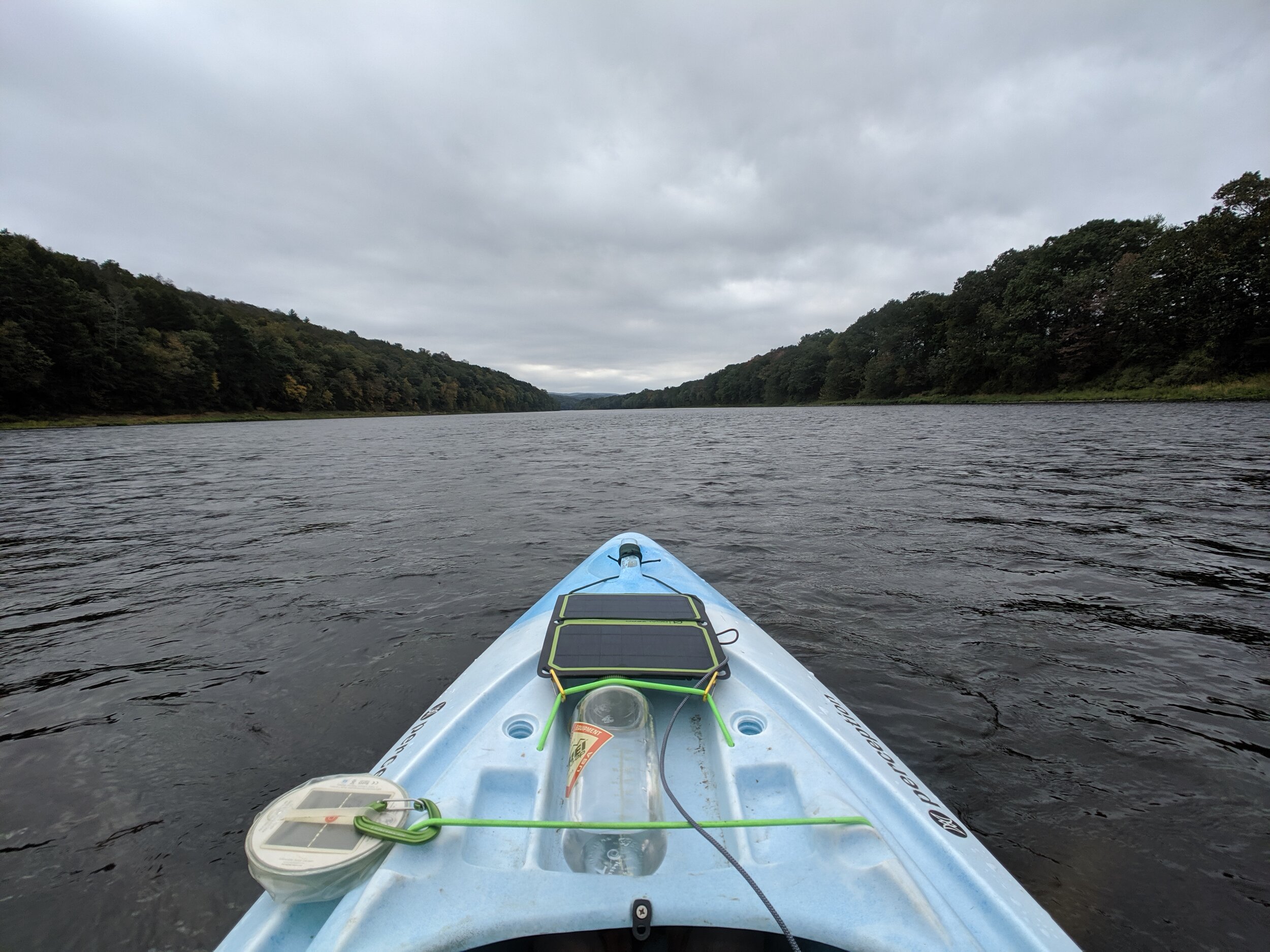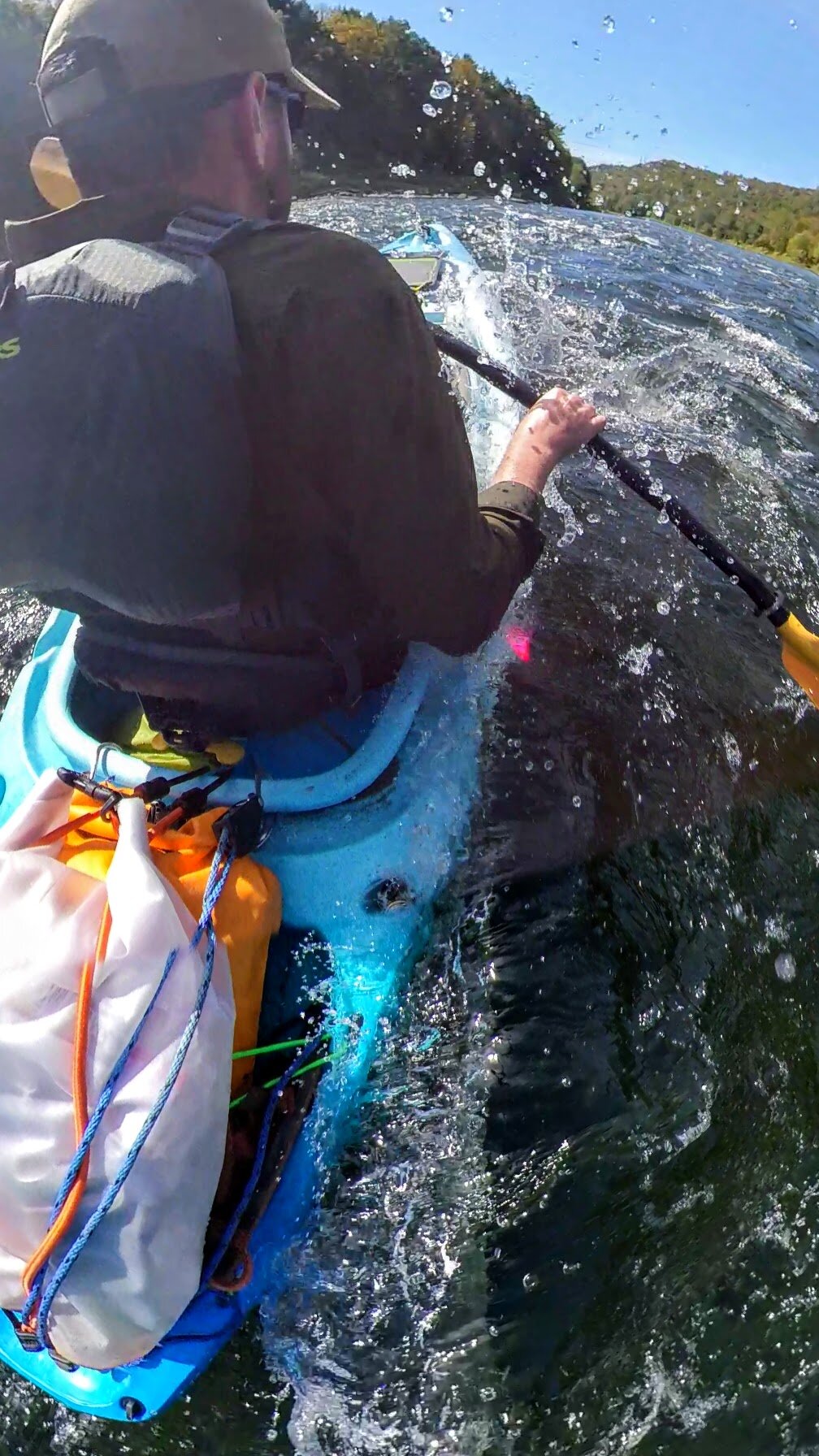River Adventure: Kayak Camping on the Delaware

It was an unseasonably warm fall and I had a 3 day weekend coming up so I decided to take advantage of it.
The Delaware Water Gap Recreation Area has always been one of my favorite spots in NJ to hike as the Fall leaves change color, so I was excited by the opportunity to give kayak camping a shot for the first time in this familiar terrain.
The plan was to park at the Kittatinny Visitor Center between Mt. Tammany in NJ and Mt. Minsi in Pa. My kayak and I would then hitch a ride upriver to Dingmans Ferry using the Adventure Sports transportation service.
Over the course of the next three days I would paddle 27 miles down the mighty Delaware to where the river breaks through the Kittatinny Ridge of the Appalachian Mountains, at a location appropriately named the Delaware Water Gap.
Day 1:
I checked in with Adventure Sports 9am. After picking up a few other fellow adventurers, we were on our way to Dingman’s Ferry, Pa.
At about 11am we reached our destination at the base of the Dingman’s Ferry Bridge, one of the last few privately owned toll bridges left in the United States.
After some last-minute gear tie-downs and adjustments, I was in the water and heading South.
This had been the trickiest part of planning. Getting all of my gear to fit into my small kayak without throwing it off balance. Too much weight in the rear and the smallest of rapids could swamp the boat, bringing the excitement to a disappointing wet and premature end.
Been there Before.
With the right combination of drybags and some creative packing, I was able to figure it out. But if I were to do this again in the future, I might bring a canoe instead for the extra cargo space.
The weather at launch was less than optimal. There was a headwind so strong that if I stopped paddling it would have pushed me back upriver against the current.
Luckily the wind calmed down after a few hours, and the clouds eventually opened up to blue skies.
As the day ran on, I started to keep an eye out for possible campsites. The Water Gap area has no shortage of permit-free primitive campsites along its banks, but I had my heart set on finding an island in the middle of the river, and I was determined.
Eventually, a tiny sand island caught my eye so I landed to scout it out.
“Island” was a pretty generous term for what I was looking at. It was more like a peninsula with a small stream separating it. But beggars can’t be choosers. I beached the kayak and began to collect firewood.
Once camp was set up, I cooked myself some dinner and watched the sunset over the trees.
Day 2:
I will never sleep on a sand beach ever again if I can avoid it.
Somehow this sand found a way to break every understanding I had of the realities of space and time.
It was in my tent, in my dry bags, in my food, in my clothes. It was wedged into places I didn’t know I had.
I totally understand where Anakin was coming from.
Once I was able to brush myself free of the sandy situation, the morning was actually quite enjoyable. I had woken up to the defused light of a foggy sunrise. There was a cool dampness to the air which made a hot breakfast all that much more enjoyable.
I was in no rush, so I sat there sipping on my coffee, listening to the water, and watching the sun burn off the morning fog.
After breaking down camp, I was back in the kayak and headed downriver in what would be my longest day of the trip.
This was my first kayak camping experience so I really did not know what to expect as far as how long it would take me, or how many miles I would be covering in a day.
I had been tubing on this river before with friends. And if I recalled correctly, it took us a good half of the day to flow 6 miles with the current, but I wasn’t sure how much quicker I would be moving in the kayak.
Most of the day I was casually paddling my way downstream, but in areas where the current picked up speed, I would just lean back and relax and take in the sights and noises of the river.
That is one large advantage of kayak camping over backpacking. Even when taking a rest, you are still on the move.
On the whole, the first half of the day was incredibly peaceful. What is it about water that just quiets the mind and makes us so calm?
I got a lot of thinking done in that quiet calm. It reminded me of when I was younger, before smartphones. Sometimes, you would just be bored, and in a way that was a good thing. It allowed your mind to wander. New ideas would pop up, sparking new miniphanies (mini-epiphanies, a term stolen from a friend).
It’s odd. We pretty much have the entire aggregate of human knowledge at our fingertips, accessible to us at all times, but we spend so much less time thinking. To stave off boredom, we scroll.
Maybe that’s why I like backpacking so much. It allows me to disconnect and get bored, leaving plenty of breathing room to think and ponder.
We should get bored more often.
All that thinking, however, was interrupted but the subtle and distant roar coming from up ahead.
I was warned by the maps of this area that once the river snakes around into a hard 180-degree, a series of class 1 rapids would start.
Being a novice to river kayaking, I had no idea what class one rapids meant. All I could find was that it was rougher than calm water, and not quite as rough as class 2.
Great.
My biggest concern was keeping the bow straight. With all this extra weight, hitting a wave broadside could easily take the kayak down which would definitely put a damper on the trip.
I know it would make me damper.
So my oar would become my rudder, used only for steering as I surrendered to the rapid currents.
They started off smooth enough. Just a few crests and troughs here and there. “This wasn’t so bad”, I thought to myself.
I thought too soon.
Moments later a white-crested wave slammed the underside of the already lifted nose, forcing the bow to crash back down into a trough, and causing the whole craft to roll and veer to the left.
I was quickly able to right myself before the next crest came, but not without significant heart palpitations and the need to check that it was only river water that was now making my seat wet.
I am being slightly dramatic. Honestly, it was actually kinda fun. But I think I’d steer clear of any class 2 rapids in the future. Just to play it safe.
The rest of the day was calm. Some parts of the river were so calm, the water looked like glass.
As the sun was getting lower in the sky I began to look for my next campsite. Originally I had planned on setting up on Tocks Island in the middle of the river, but that plan came from just looking at topographical maps. When I got there, the shore seemed too rocky to be comfortable and inland from that was far too overgrown.
So I continued on.
One thing I did not anticipate was how uncomfortable sitting in a kayak for eight hours was going to be. It really does a number on the lower back.
Luckily, only a mile or so later I found my spot. It was on a small, wooded, unnamed island to the North of Labar Island. With its small rocky beach and an elevated camp area, it was perfect.
I set up camp, prepared to stargaze and settle in for the night.
Day 3:
The next morning was clearer than the last, but chillier. This was the first day that truly felt like Fall.
I savored the crisp air as I sipped on my last cup of coffee of the trip.
This chill continued throughout the morning, and the overcast forming in the skies seemed to want to keep it that way. Without the sun to dry me off, I decided to wear my rain jacket to keep me warm and dry for the last leg of the journey.
Today would be a shorter day than the last. Only about 6 miles to the gap between the mountains.
The early morning was peacefully quiet. Only the birds and the subtle sounds of the kayak’s bow cutting through the calm water could be heard.
As I paddled past Worthington State Forest campgrounds to my left, the smell of bacon filled the air as the families of campers prepared their morning meals. After three days of dehydrated backpacker food, I was almost tempted to stop and invite myself over for breakfast.
As the morning went on and I was nearing the end of my trip, I came across some bridge ruins. I later tried to look into their history but came up with nothing. If anyone can help out with that, leave a comment down below. My only guess is that it had something to due with a nearby abandoned mine since what was once a bridge seemed to link up with “Old Mine Road”.
Very shortly after that, I came to a bridge that was very much still active. Interstate 80, the highway that breaks through this gap in the mountains to connect New York City to Cleveland.
Brave Appalachian Trail Throughikers have to cross this highway bridge on foot to cross from Pa to NJ.
As I cleared the bridge, the river turned and revealed the beautiful and familiar sight that was Mount Tammany, letting me know that my journey was about to come to an end.
I beached my kayak at the Kittatinny visitor center, loaded up the Jeep and got back on my way into civilization.
This was one hell of a relaxing three-day weekend.
UPDATE: If you are interesting in trying this trip yourself, know that permits are now required for the formerly ‘first come first served’ backcountry campsites. And may I suggest perhaps the best guidebook for this entire region "Paddlers' Guide to the Delaware River".
alltrails.com




















